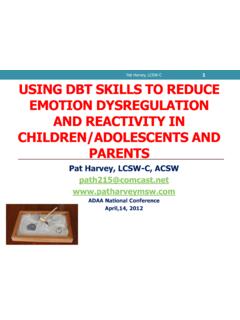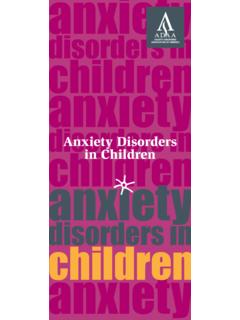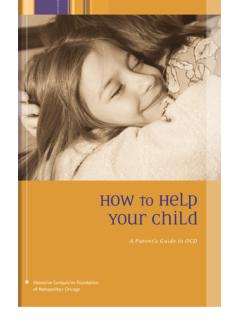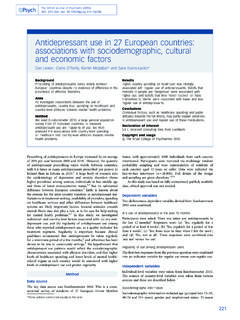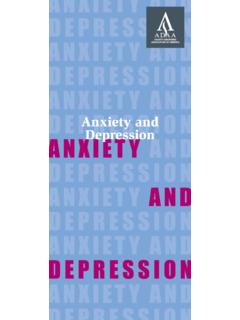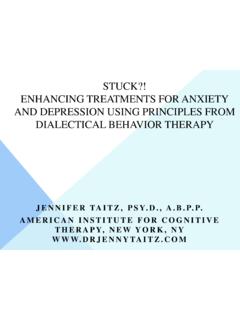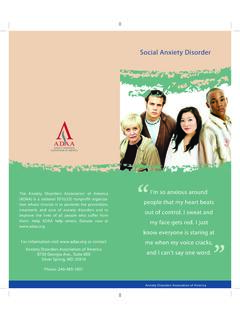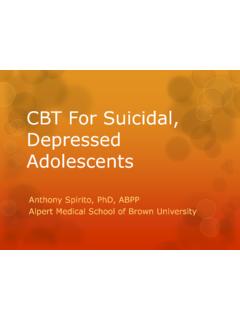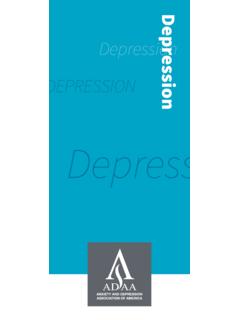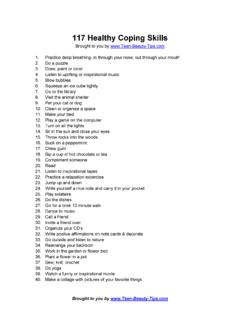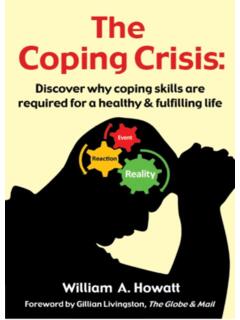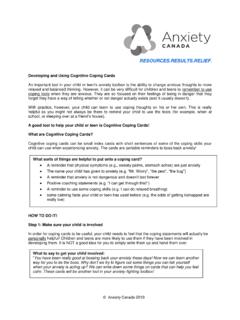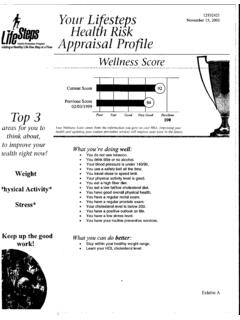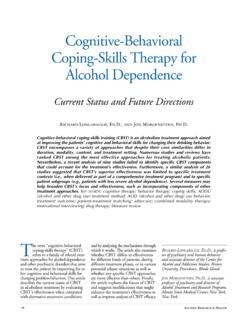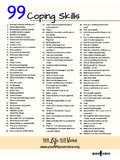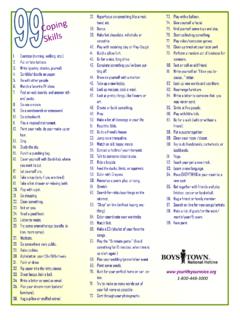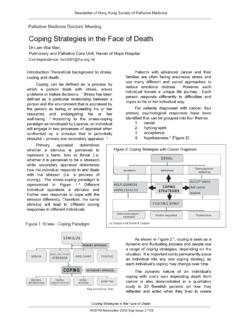Transcription of Distress Tolerance and Skills Building for Adolescent
1 1 Distress Tolerance and Skills Building Group for Adolescents Hotel Dieu Hospital Division of Child & Adolescent Mental Health Services Anita Peter RSW 2 Disclosures No funding or financial supports were or have been received 3 Today s Objectives Summary of the Distress Tolerance Group The Audience will engage in Mindfulness Activity and Practice Demonstration and practice of coping Strategies and a list of Resources will be provided 4 What is The Distress Tolerance and Skills Building Group? Dialectical Behaviour Therapy (DBT) informed Group that has been modified to meet the needs of Adolescents and Teens DBT was developed and created by Marsha Linehan to Work with Adults with Borderline Personality Traits (BPD) 5 Dialectical Behaviour Therapy Created to include a Zen Buddhist experience to a Cognitive Behaviour Approach to Treatment People are doing the best that they can in the context of their lives and they need to do better by learning Skills Acceptance and validating one s life situations and using that to create change for oneself are core components of DBT.
2 This allows for supporting and working with Individual with chronic or pervasive emotion dsyregulation 6 Many of the teens referred have a diagnosis of BPD Patterns in their everyday life that are or may be consistent with some BPD traits These may include, maladaptive, unsafe and unhealthy coping , patterns of unstable relationships, impulsive and possibly risky behaviours, and emotion dysregulation. 7 Everyone gets Distressed! 8 Who are the Teens that come to Group? Adolescents from 13-18 yrs Adolescents who may engage in self harming behaviours including, cutting, scratching, skin picking and biting and possible overdoses Teens who have difficulty regulating their emotions and exhibit more chronic emotions dysregulation Poor, unsafe and unhealthy coping strategies Problems with their interpersonal relationships, patterns of unstable and chaotic relations All of the teens attending group have a Mental Health Disorder diagnosis, this can include (but are not limited) anxiety disorders, depressive disorder/mood disorders, substance abuse, eating disorders, Attention-deficit/Hyperactivity and conduct disorders.
3 Some of the teens also may have Learning disabilities or low intellectual functioning 9 The 4 main Topics Covered are: Mindfulness Managing Emotions Taking Care of Relationships Distress Tolerance Strategies 10 What are teens doing in group? Mindfulness Practice Cognitive Behaviour Therapy Relaxation Strategies Communication Styles Crisis Management 11 Starting your own group Know your Resources Practice the Skills yourself first Keep the groups Small, 8 teens and under 2 facilitators is ideal Prescreen the Teens for Motivation, Reasons for attending group and compliance to Rules and confidentiality. Keep the group length at 2 hours or under Feed the Teens Provide Practice sheets/Homework each session Include the parents/guardians if possible 12 What to include in a group? Mindfulness Practice each session Mindfulness helps children and adolescents learn to become more self-aware of their thinking, their emotions and any physical changes Improves and increases concentration, memory and focus Helps teens stay with the present moment, rather than worrying about the future or ruminating about the past Mindfulness practice each week allows them to become more attuned to interactions with peers, family, strangers It helps them to think more carefully about their own emotions and how they could react versus how they would react.
4 Ideas for Mindfulness with Children and Teens Mindful eating (raisin, chocolate)* Mindful observation and non-judgmental (magazine faces) Mindful breathing (body scan) Mindful drawing (coke can, Pepsi )* Mindful writing (writing with dominant hand and then non-dominant hand) Mindful relaxation (Progressive Muscle relaxation) 13 Practice Mindful eating 14 15 What to include in group continued Cognitive Behavioral Therapy Useful in helping teens understand that emotions are not separate entities and are very much influenced and linked to our thoughts CBT helps children and teens to learn to identify and work through negative distortions or thinking patterns, in a mindful manner. CBT helps the teens challenge any automatic (hot thoughts) or negative thinking patterns. CBT helps teach the teens that they in fact are accountable for their actions and have the power to change their pattern of thinking CBT helps teens focus on the here and now, opposed to dwelling on past issues to gain insight into their emotional state of mind Use either real life examples if a teen wants support with it, or an example that would fit with a teen s current life situation.
5 Examples: Thought Records/Single Incident Reports 16 What to include in group continued Relaxation Techniques Complete at least one strategy per session and do the technique with them Helps to identify physical changes in their body when there are relaxed vs stressed/not-relaxed Gives them different tools to use in different situations Encourages the use of different tools to manage stress A variety of tools for kids/teens are recommended to keep them engaged, interested and gives them options for which strategy works better for them Relaxation often doesn t require equipment and teens can be encouraged and convinced to use these techniques virtually anywhere Examples: Guided Imagery, tense and release, 3 senses, Body scan, calm breathing 17 What to include in group continued Naming, Managing and Regulating Emotions Increases children and teens feeling words/vocabulary Helps the children and teen to start connecting the emotion with urges and reactions and possible outcomes Awareness of one s emotions and ability to name them, allows more opportunity to manage the emotions in a healthy and safe manner Increases the ability to communicates to others what he/she is feeling Teens learn that emotions have a functions/job and are normal experiences and expressions throughout life Increases the chances of a more stable interaction or relations with others Better sense of self (decreases the sense of feeling emptiness, not knowing who she is, Linnahan 1993) Example.
6 Have kids list out all emotions Practice sheet to decipher between emotion, thought and reaction 18 Practice Managing Emotions Progressive Muscle Relaxation 19 What to include in group continued Communication Styles Identifies what form of communication is being used generally (passive, aggressive, passive-aggressive or assertive) Decreased stress: Stress can be better managed with assertive communication (setting up boundaries, limitations) and recognizing need to do vs want to do Teens have an opportunity to express their feelings and thoughts and to also engage in meaningful conversation with others Develop self-control: Learn how others communicate in a constructive and effective manner rather than leading with emotions and having regrets Teach the importance of attending behaviours, eye contact, body language, tone of voice and verbal tracking/verbal exchange Example: role play scenarios, How do you communicate Sheet 20 What to include in group continued Distress Tolerance / coping Skills Basic idea is to learn how to make it through a bad situation without making it worse.
7 Learning how to tolerate Stress and accept what is Recognize that no matter how bad it feels, they will survive Using distraction in the moment of crisis, gives them time to cool down and think more clearly and logically through the situation Can help prevent teens from following through with urges that are unhelpful 5 senses (vision, hearing, taste, touch and smell) Self-soothing Skills (relaxation, visual imagery etc.) Listing out the Pros and Cons and Engage in Pleasant events 21 Distress Tolerance / coping Skills Con t Distracting with activities, contributing, thought stopping, pushing away Improve the Moment: With imagery, relaxation, finding some meaning in the current situation, mindfulness (one thing in the moment) and immediate items to help self-sooth (listen to music, read a book etc) Create and develop a coping /Soothing Box Examples: Pleasant event list Pros and Cons sheet 22 What s in your Box?
8 ? Items used to soothe and manage Distress Items that are safe and healthy Magazines, CD s Telephone numbers candy, treats, hot chocolate, teas Books, movies Pictures of friends, family, pets 23 Limitations of the group Length and frequency of the sessions Maintenance Treatment after group termination Parent group Co-morbidities (eating Disorders, Learning Disabilities, ADHD etc Family Environment) Availability of Therapist for Individual work and Facilitator Burnout 24 Group Session Sample #1 Group 1 Mindfulness 1 Introductions and ice breakers 2 Goal Setting 3 Pre-test Measure Mindfulness eating (raisin, Chocolate) practice. (magazine with faces) Reading (Row your boat, Yellow Bird) Scan coping /Soothing Box for next week (7 day mindfulness Tracking) 25 Group Session Sample #2 Group 4: Taking care of Relationships and Introduction to Distress Tolerance Skills , Check in , Homework and goals Reading (row row your boat, the Yellow bird) Relationships, why is this important and who are they way of thinking sheet Styles sheet, which one are you?
9 Examples (role play) Visual Imagery Drawing (Pepsi or Coke Can) to Distress Tolerance Skills (self-soothing Skills ) Box Reminder relationships Sheet 26 Example Scenarios for Role Play You mom has asked you for one week to clean your room but you haven t. You want to go to the party tonight but you mom says you can t go because you haven t cleaned your room. You find out that two of your good friends went out to the movies last night without you. Your sister keeps borrowing your clothes from you room without asking you. You purchased a new top at the store and you get home and realize that you were overcharged. What would you do? You ask your sibling to go to the movies with you and he/she says no. You re feeling overwhelmed with school work and having arguments or disagreements with you girlfriend/boyfriend. You come home really upset and stressed out and your parents ask you to help out by setting the table for dinner 27 Row, Row, Row your Boat gently down the the stream, merrily, merrily, merrily, merrily, merrily life is but a dream 28 The big and bright red bird flew through through the orange curtains into the blue sky 29 What is your Communication Style?
10 I try to push my feelings away rather than express then to others I worry that expressing myself will cause others to be angry with me or to not like me. I often hear myself saying I don t Care or It doesn t matter to me when I do care and it actually does matter to me. I try not to rock the boat, keeping quiet because I don t want to upset others. I often go along with others opinions because I don t want to be different. Total: I am concerned with getting my own way, regardless of how it affects others. I often yell, swear, or use other aggressive means of communicating My friends are often afraid of me. I don t really care if others get what they needs as long as my needs are met. I ve heard others say that I have an it s my way or the highway attitude. Total: Adapted from Van Dijk, Sheri.(2011) Don t let your emotions run your life for teens 30 What is Your Communication style I have a tendency to be sarcastic in conversations with others.
